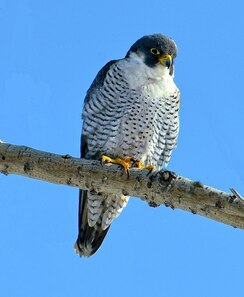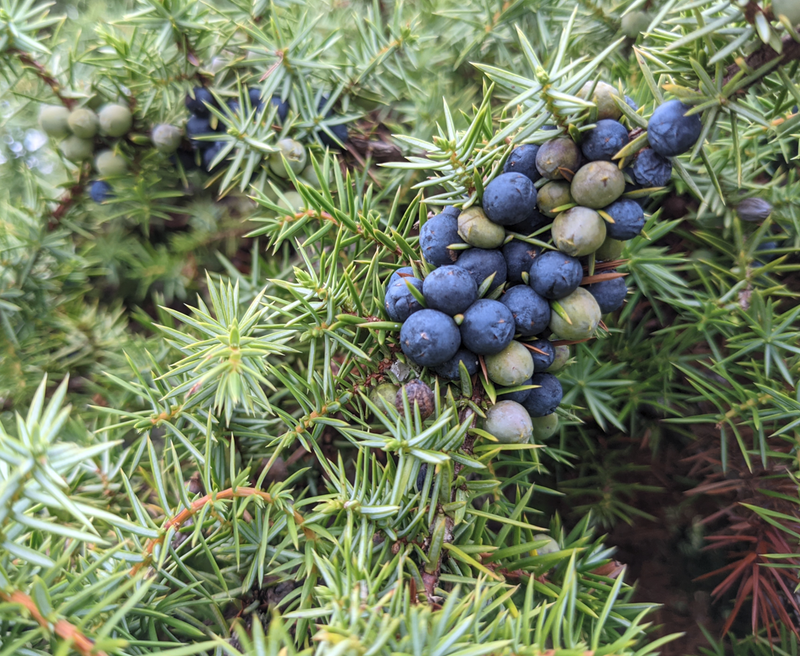|
Sheltering from the driving rain behind a Bakewell Slice in the cafe at the Wilton Garden Centre, I noticed a Martin of some sort fly over beneath the low clouds. Then another, and another. As I watched, there was a steady stream of them heading north westwards up the Wylye Valley, presumably forced down by the low cloud and rain. Without bins I couldn't make out whether they were Sand or House Martins. I thought it likely that they would be Sand Martins.
On the way back I diverted to have a look at Fonthill Lake and sure enough there were scores of Martins there too, scooting around over the water, and against the backdrop of the surrounding trees I could see that they were Sand Martins, which generally are the first of the Hirundines to arrive, I think. I suppose they use the valleys are convenient routes to follow and the Lake a useful feeding stop on their migration to wherever it is they will be breeding. In spite of the weather spring is on its way... Andrew Graham Juniper scrub prospers well on rocky screes, exposed to the light, away from heavy grazing activity. Matt Pitts, Meadows Adviser at the Salisbury-based environmental charity Plantlife, showed us striking photographs of sites in Cumbria and the Caledonian forest where juniper growth has persisted since the last Ice Age. Closer to home we heard about Plantlife’s project in the Wylye Valley and the Chilterns where they are regenerating juniper on chalkland downs. Not only will this conserve the habitats for the 50 species of insects and 40 of fungi which solely rely on juniper, but it will also contribute to the biodiversity of species on these sites.
Historical records of land usage show that juniper started to disappear when the downlands were fenced and the shift in grazing patterns caused an impact, with some land also being lost to arable, particularly after the Napoleonic War and World War II. Despite this, Juniper went through a mini regeneration during the myxomatosis period 1960-80 as it no longer had the threat of thousands of rabbits nibbling its young shoots. We learned a striking fact that the berries have a low fertility with only 1-5% viability, so gathering viable seed is difficult. The Juniper project team is aided by the Millenium Seedbank which stores seed and checks on viability. Plantlife mainly use two methods of cultivation: they grow from seed and store young plants in a nursery for several years until they are strong enough for planting out and they also scatter seed on prepared scrapes of chalkland. Locally they have extensive scrapes on the Fonthill Estate in the Wylye Valley where they are trialling juniper regeneration. Patience is definitely required because juniper takes a long time to establish. We saw photographs of a scraped chalk fenced area over a ten year period and only by year 3 were tiny shoots in evidence. By year 10 there were 688 clumps of juniper growing well, with a multitude of chalkland orchids, kidney vetch and other flowers naturally seeded. Matt advised against buying juniper from nurseries because firstly, it might not be a native plant and secondly it could be infected with phytophthora austrocedi, a pathogen which kills our native juniper trees. This fungus-like pathogen is difficult to detect without proper laboratory investigation and it is likely to be carried in the compost, so to preserve the strength and integrity of our native juniper we better leave the juniper regeneration to the specialists. More information about Plantlife’s juniper project is available on their website. You can now find the full listing of our Talks and Field Trips for March 2023 to April 2024 on the relevant pages of this website or as a pdf to print out. Members will receive email newsletters with more details closer to each event and Blog posts will follow as reminders. We look forward to your company!
Don't forget to sign up to the notifications for our website news by popping your email address into the subscribe box on the Blog page. This box is visible towards the bottom of your screen when viewing the Blog page on a mobile. Talk on Thurs 16th March at 7:30pm: Revitalising Wiltshire's populations of Lowland Juniper11/3/2023
Matt Pitts, Meadows Adviser at the Salisbury-based environmental charity Plantlife, is coming to give us a talk on his project to reinvigorate juniper’s growth after its significant decline and protect the wildlife that depend on its presence.
Over the past 60-70 years there has been an 80% loss in the area of chalk grassland in Southern Britain. Fragmentation of the habitat and a reduction in extensive grazing has resulted in a loss of plant species and of biodiversity more widely. Juniper is a specific example that faces extinction in southern Britain. Across our downlands, this iconic shrub has failed to regenerate for the past sixty years. As bushes reach the end of their lives, whole colonies are dying out; it has been lost from nearly 50% of its historic range. If this trend continues, over 100 specialist invertebrates and fungi that depend on the juniper to survive will disappear too. But although juniper is the focus for Matt’s project, the work is benefiting chalk grassland conservation overall. Since 2009, Plantlife has been trialling in-situ techniques to regenerate juniper from seed. 10 out of 14 trial sites now boast healthy populations both of young juniper bushes and populations of other wildflowers and plants. Focusing on the themes of nature conservation and connecting people with nature, Plantlife are now working to reinstate lost juniper landscapes on a larger scale, initially in the Wylye Valley and on the Berkshire Downs. The Victoria Hall, High Street, Tisbury and its bar, will be open as usual from 7:00 p.m (cash & card payments). Members and those under 21 have free entry and we welcome any visitors to join us and pay a guest fee of £2. Please bring cash for guest tickets! Our Young Nature Watch branch would like to invite our members and followers to their event this month, which is a dung beetle hunt, on Saturday the 11th of March at 10 o'clock; the meeting point (at the entrance to a field in Swallowcliffe) will be confirmed for those who book a space by getting in touch. People of all ages are always welcome to join our Young Nature Watch activities, although we give priority to people under 21 years of age if we are overbooked. In this case we have plenty of spaces left so do not hesitate in joining if you are interested in learning about beetles! We will be led by ecologist Gareth Harris (Wiltshire's mammal recorder) and he will explain why dung beetles are very important for mammals and particularly bats. Attendants will be sent to collect interesting dung in a field we have previously surveyed and after that, we will all gather round and extract the beetles from it. Interesting dung in terms of beetles is not fresh dung, so if you are squeamish worry not about this.  Young local residents becoming interested in our recent dung survey. Young local residents becoming interested in our recent dung survey. Because it's going to be cold and beetles may have hidden elsewhere to keep warm, we have collected some dung in advance as a precaution, so it is entirely possible to take part in this event and not touch any dung! (Note: the landowner intends there won't be any cows in the field when we get there on Saturday). Gareth will explain interesting facts about the beetles we find. Did you know that there are many different species of dung beetles? Did you know that some dung beetles are entirely nocturnal and they guide themselves in the landscape by looking at the position of the stars? Find out more about this and other fascinating details about our local dung beetles on Saturday!  Male peregrine (Toronto) by Mykola Swarnyk, CC BY-SA 3.0 via Wikimedia Commons Male peregrine (Toronto) by Mykola Swarnyk, CC BY-SA 3.0 via Wikimedia Commons I was woken by the distinctive cry of a Peregrine above the garden and sprang up to watch it repeatedly stooping on a crow, which seemed to be enjoying the fun rather than making any real efforts to get away. A new species for my "from the bedroom window" list and the first time I have seen one actually over Tisbury (usually up on one of the local ridges) so it confirms the entry in the bird list that I’m working on for this website. I gather that the cathedral breeders scout out a considerable distance from the tower or it may have been a roving winterer. I am ignorant of the extent of quarrying still going on at Chicksgrove, so I am wondering if there is scope for them to nest in there undisturbed? [editor: no Tisbury photo available yet!] Andrew Graham We are meeting on Saturday the 4th of March at 10.30 am in the field behind King George's Field and the Skate Park for some winter
maintenance. We have done two hedgelaying sessions earlier this year; this time we will be looking at how the trees we planted in years past are doing, removing any grass from inside the guards, adding woodchip, replanting gaps with hedge trees, replacing missing stakes and guards... You are welcome to join us. The best place to park is the Nadder Centre car park, from where there is less than a 5 minute walk to the field:https://goo.gl/maps/NwoqRXzTFBxWC3hGA Now is the time when we think of Mad March Hares: seeing the animals chasing around in a field, jumping over each other and “boxing”. This behaviour, which is actually not restricted to this month, is all about courtship or partly, the refusal of courtship. Male hares – bucks - are more numerous, so females – does - that are unreceptive to amorous mates may vigorously fight them off. A female leading a potential mate on a chase across a field may be testing his speed so she can select the fastest male to father her offspring. She can produce three or four broods of young a year. These are called leverets and are born fully furred and ready to run. They will keep themselves hidden during the day returning to the doe at sunset for a daily feed and are weaned in a month.
Brown hares are preyed upon by foxes, stoats and buzzards but also subject to poaching and illegal hare coursing. They do not burrow like rabbits but live above ground and so rely on their speed to evade predators and escape to cover. They are the fastest British land mammal and can reach 40 mph at full pelt. Its long back legs provide this speed and results in a distinctive loping gait very different to that of the rabbit which is about half the size and weight. Rabbits have black eyes, very different to those of the hare which are a wonderful amber. Its ears are much longer than the rabbit with distinct black tips. Their fur is golden brown with a white belly. The other hare seen in the mainland UK is the mountain or blue hare which is mainly found on Scottish heather moorlands. The best time to see Hares is early or late in the day. During the day they may lie up in a depression on the ground called a form. They will sit tight when approached before hurtling off at the last moment, often stopping after a while to look back then loping off at a more sedate pace. If you are lucky enough to spot them before they speed off, you can have a staring match and see how inconspicuous they make themselves, hunkered down with their ears lying along their back. You are most likely to see them in arable farmland and wide-open grasslands, woodland edges and hedgerows – places which provide shelter. So they benefit from a mixed agricultural landscape rather than one devoted to a single crop. The downs along the Shaston Ridge and the arable fields adjacent are a favourite place to see them and they can be seen in vicinity of Tisbury although dogs running off leads scare them away before most people see them. Unfortunately, hare’s numbers are estimated to have declined by 80% in the last 100 years. Some are now suffering from rabbit haemorrhagic disease which further threatens them. We are fortunate to still have these beautiful animals in the countryside around us. by Andrew Graham |
Photo: Avocets (Izzy Fry)
The headers display photos taken by our members. Do get in touch via the Contact Form if you'd like to submit a photo for selection.
Archives
May 2024
Categories
All
|




 RSS Feed
RSS Feed